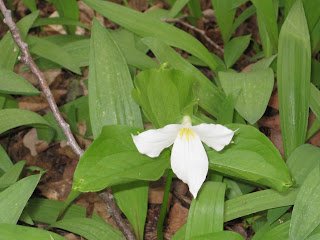Saturday was a good day at Forest Hill for a hike with my dog,
Remi. The early morning weather was mostly cloudy with a temperature of 37 degrees and a slight east wind. At the crest of the hill, I paused to ponder the
view to the west. I descended the hill, passed Mallard Marsh and meandered through Bobolink Meadow, where I noticed many Dandelion blossoms had gone to
seed. I followed the trail into North Woods where I spotted a few Yellow
Violets. Continuing west, I came to the boardwalk and paused to look over the overflowing
vernal pond. Before exiting the woods, I got off the trail and continued west about 30 yards to find a patch of
Wild Leeks or Ramps. The mountain folk of Appalachia have long celebrated spring with the arrival of the ramp, believing it to have great power as a tonic to ward off many ailments of winter. Indeed, ramp's vitamin and mineral content did bolster the health of people who went without many green vegetables during the winter. Much to my surprise, I also saw my first
Trillium growing close by. This is one of many plants whose seeds are spread by ants. At maturity, the base and core of the trillium ovary turns soft and spongy. The ants take the seeds and the decaying ovary to their nest, where they eat the ovary and put the seeds in their garbage, where they germinate in a rich growing medium. Exiting the woods, I followed the trail around Succession Field, where I noticed it was dotted with very tiny white blossoms of
Thyme-leaf Speedwell. Continuing on, I stopped to observe and smell the white
blossoms on a Wild Black Cherry tree. While standing there, I recalled earlier in the week being excited to see and hear a rare male
Ruby Crowned Kinglet perched on a tree nearby. I suspected this small bird was heading to its summer breeding habitat in the spruce-fir forests of the northern, mountainous United States or Canada. Next, I got off the trail to investigate a small tree that had a silky nest of
Tent Caterpillars attached to it. I entered South Woods and hiked along the edge of Swanson Swamp where I observed several
spore stalks of Sensitive Fern. Exiting the woods, I continued past Artist Overlook along the edge of
Sora Swale. I turned east and then turned south off the trail to the edge of the neighbor’s field to observe a patch of white flowers of
Hoary Cress, considered a noxious weed by farmers. Back on the south trail, I came to Frog Fen and turned toward Brady Cemetery. I passed the cemetery and entered
Native Grassland to see that it was greening up since the controlled burn 3 weeks ago. I continued north past Grebe Pond and came to the Classroom Building where I spotted a
rabbit sitting on the lawn. Finally, we jumped in the van and took off for civilization.
Signs of spring are here and there
Woods trail is muddy and bare
Colorful blossoms dot the ground
Pond frogs make their sound
Wood ducks takes to flight
Awakened squirrel is in sight
Call of a goose is loud and clear
Woodpecker drums very near
Blades of grass peak through
Giving the meadow a greenish hue
Returning Grebes begin to dive
Mother Nature is coming alive.
D. DeGraaf



